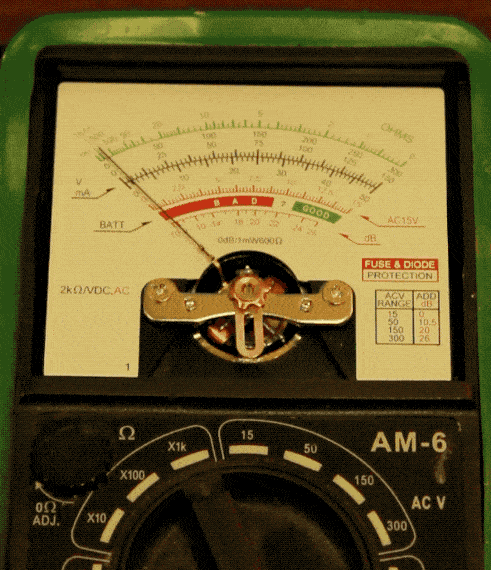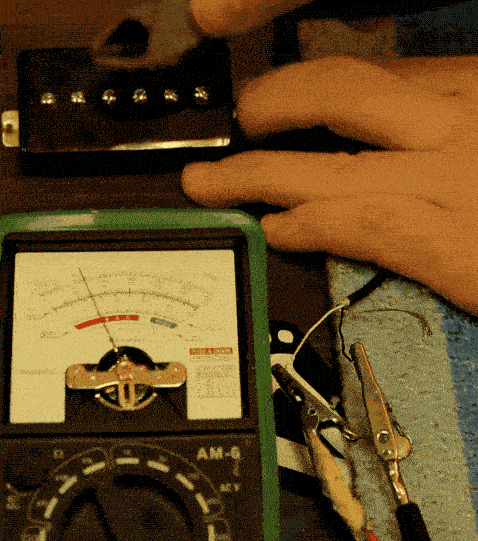
How To Use A Multimeter with Guitar Pickups
The Multimeter is one of our most-used tools in our workshop. It’s used to test pickup continuity, phase, and resistance of our pickups. Within a few seconds, we can test a pickup to determine what might be wrong with the pickup. Let’s talk about how we use our Multimeters, and how you can use this powerful tool correctly!
The Basics of Using a Multimeter With Your Guitar:
Once you understand the basics of using a multimeter, you won’t look back. The multimeter is one of those tools that gives you a super power: see the flow of electricity and diagnose wiring issues. With a multimeter, you can:
- Check if a guitar pickup is healthy or not by reading it’s resistance
- Find a short by finding where the signal is broken
- Diagnose ground issues by finding what part of your guitar isn’t grounded properly
- Check the phase of a guitar or bass pickup
What setting Do I Use?
The Multimeter comes with a wide variety of settings out of the box, and while it’s main use is for home electrical tasks (like checking to make sure an outlet is healthy), there are other features that work really well for the guitarist or musician:
- AC Voltage: You can use this setting to test Wall Current, not really applicable to the guitar, but could be helpful if diagnosing power issues in your home or studio.
- DC Voltage: Test a battery to see if it’s good or not! Very handy to have if you have a lot of guitar pedals, or you’re just not sure if that battery in your gig bag is actually a good one.
- Resistance (Ohms): Our most-used setting. Test a wide array of issues and get the shortcut to your problem quickly!
- Continuity: Can be helpful, but doesn’t give you as much information as Resistance.
Digital Or Analog?
Either style of multimeter will work, but if you’re a serious bench tech, it’s a good idea to have both, as both have their strengths and weaknesses:
- Analog: Analog, or what we call a “Needle Meter”. It’s a great way to quickly check resistance, but we use it all the time to check the phase of a pickup (More on this below). If you opt for an Analog meter, be sure to “zero” your meter first. See below on how to do this:

- Digital: Digital Meters are probably the most readily available and most useful meters. There are some things that are more difficult to do with a Digital Meter. However, it offers the most accurate Resistance readings out there, and they require no calibration.
What Can you Do With A Multimeter?
Checking The Resistance:
Resistance is a term for measuring the difficulty to pass an electrical current through a wire or circuit. We use this all the time, and there’s a lot we can learn from measuring the Resistance of a guitar pickup. We use this setting to test if a guitar pickup is healthy, comparing two pickups, diagnosing problems, and testing the continuity of a circuit.
Checking the Continuity With Resistance: If you get an Ohm reading from a guitar pickup, it has continuity. You’ll get an Ohm reading, showing that the electricity is going from Point A to B, which is Hot to Ground.

Testing Continuity
Continuity is the flow of electricity through a circuit. If a circuit has Continuity, electricity can get from point A to point B. If a circuit doesn’t have Continuity, there’s a break somewhere in the signal path. We use continuity to test grounding issues, and testing whole circuits on a guitar.
There are a few ways to test Continuity. Most new digital meters have a Continuity feature, and you’ll hear an audible “beep” when the circuit closes (that setting won’t work for guitar pickups). If you don’t have a Continuity feature on your meter, you can test continuity using the Resistance setting.
Continuity Readings
See the two images below on how to determine if the connection is healthy of not:

Using the Resistance setting, you can see that the circuit is healthy when there’s no resistance. Basically, electricity is freely flowing from point A to B.
Real World Example: Let’s say you’re trying to hunt down a grounding issue in your guitar. By touching one of the terminals to a common ground (the back of the volume pot, for example), you can use the other terminal to see which other part of the guitar isn’t grounded. You should see a “0.0”, or close to “0” as possible, to see that there is a healthy connection with ground. If you see a “0.L”, you know there’s a break somewhere in the signal path and that’s the item that needs to be grounded.
Checking The Phase (Needle Meter):
Testing the phase of a pickup is a great way to see which way the pickup “Meters”. We use this all the time when doing install work. It’s a quick way to determine if a new pickup will be in phase with your other pickups or not. Here’s how you do it:
- Set your Meter to measure Resistance.
- Attach your Red Wire to the Hot of the guitar pickup
- Attach your Black Wire to the Ground of the guitar pickup (you should have an ohm reading now)
- Use a Steel Item (screwdriver / pair of pliers) to touch the magnets and observe what happens to the needle when you pull away the Steel.


The above gif has a pickup that meters down. When we pull the steel away from the pickup’s magnetic field, the needle is pulled towards 0 Ohms.
If you wanted to reverse the phase: You could swap the leads. Reversing the White and Black leads from the pickup will make this pickup Meter Up.
Real-World Example: Let’s say you just bought a pickup with multiple leads, like the 2-Conductor seen above. You’re about to install it in your guitar that already has a pickup installed. You can take a Phase check of both pickups to see how you wanted to wire the new pickup. If your original pickup meters up, and your new pickup meters down, reverse White and Black to reverse the phase.
Well, that’s about it for now. We use these handy multimeters all the time when diagnosing and checking our guitar pickups, and you should too! Let us know if you have any other questions!
Comments
22 Comments For This Post
Leave A Comment
Want to chime in to the conversation? Please do so! Please respect others.







Thanks for this article!
For Steve:
Check under your pickguard/rear access plate for loose connections!
To solder backs of “pots” just hold your soldering iron to the thing until the pot gets hot enough to take solder.
Push some solder onto the hot pot.
Then you can heat a wire and slide it into the solder!
Thanks!
What multimeter models would you recommend?
I have a Fender Jazz bass with no output from the bridge pickup. My soldering skills suck. I can generally solder to a lug but have no luck soldering to pot casings. I just installed a new jack in another Jazz bass and my 25-watt Weller could not even melt the original Fender solder. I had to cut the wire and had no problem melting my own solder. My question: is there a way to test the bridge pickup and/or pot with a multimeter without removing it? I would like to attempt to fix it myself, buying either a new set of pickups or a pre-wired harness (always wanted a Jazz with concentric knobs). If I could determine where the issue is without de-soldering, it would save me from wasting money.
Can you damage pick ups by using a multimeter incorrectly? Thank you!!!
Hey David, not to our knowledge.
I have been trying to find information on testing active pickups but no one seems to have the answer .Do you test them the same way as passive?
Ever check resistance on an active pickup? I have a weak pickup and I’m trying to figure out if it’s the pickup or lack of power to it. Neck was 21k and bridge was 43k. The bridge seemed a bit high, but I never measured an active pickup before.
Hi… One thing that would be really useful to know would be whether the resistance of a pickup can be accurately measured whilst the pickup is still mounted/connected in the guitar.
The method I use is just to connect a short jack patch cable into the guitar.. flick the selector switch to the pickup (alone) I want to measure.. and ensure that the Volume control is rolled max on wide open (I also ensure the Tone control is full open 10 as well.. but not sure that is necessary?)
Is the resistance reading measured in such a way, equal to such it would be, should the leads of the pickup be unsoldered and the resistance measured directly?
When people teach or pass knowledge about how to measure the resistance of pickups.. the assumption always seems to be that the pickup is separated from the guitar.
Many guitarists just want to measure the resistance of pickups in guitars that pass through their hands in order to contribute towards knowledge of tone and how to get there.. toward whatever tone a guitarist is seeking.
There are always so many questions surrounding pickups on such a quest.. from single or double coils through to magnet strengths.
Most guitarists have a multimeter for 3 reasons; checking 9v batteries, checking continuity and checking the resistance of pickups (and speakers).
Would be cool to know whether pickups testing whilst they are still in guitar can be accurate.
Much thanks for any reply..
Question I thinking of steam punking a guitar can I wire in an analog guage to a guitar without ruining the electronics when playing what gauge can I use? And whats the best way to wire it in
Awesome info. One question, why can’t we use continuity to test a pickup? Shouldn’t continuity be a great way to see if one end of the pickup wire goes all the way through the coil and out the other end of the wire? I’m confused by that. I know it doesn’t work from experience, (it just reads O.L. On me. But how can that be? It shouldn’t be an open line if the pickup is good?
Can a multimeter harm a pickup at all? Can testing for resistance weaken the magnets etc.?
Hey John,
Not to our knowledge, no. One thing that does weaken the magnets, however, is introducing a magnetic field near the pole pieces. Using a Soldering ‘Gun’ instead of a pencil will cause this.
Maybe it’s a stupid question, but I have just noticed when I opened my strat that the label on my SSL-1 bridge pickup reads RWRP so does that make any sort of difference or is it bad in any way? Haven’t noticed any problems while playing and the pickups were installed years ago by a luthier. Was he wrong or what?
Hey Mike,
More often than not you’ll see a RW / RP Middle Pickup. That will give you hum-canceling in positions 2 & 4 on your 5-way switch. That being said, Lindy likes his Strats wired with a RW / RP Bridge pickup. If you have a Blender Pot, you can achieve true Telecaster tone by selecting Neck & Bridge and have hum-canceling.
Tyler
You can still test phase with a digital multi meter using the same method, only there is no needle, so just watch the read out to see if the number goes up or down when you pull away.
Good point – it’s easier on a needle meter. With a Digital Meter, the key is to pull away slowly so you give the meter time to generate a reading.
Tyler
On a digital multi-meter it is very difficult to see the a rise or fall because the numbers flash so quickly and teeter before they settle back at the DCR. If you switch it to Volts (I don’t think AC vs DC matters) it’s much easier to spot the ” – ” (minus symbol) if it goes negative because the voltage is so so low.
Also, if you pull the steel piece away slowly, you can observe the rise or fall in resistance.
Actually, I get a good result by using a digital meter, a screwdriver, and pulling it away very quickly. If I see a momentary – or +, that tells me what I need to know.
Works for me, anyway…
I wouldn’t call a pickup measuring 7.21 ohms ‘healthy’. I think you mean k.Ohms. And probably best to give people a feel for typical ranges for k.Ohms.
Thanks for the phase tip!
After years playing with guitars and reading books, I have never read this trick.
Congrats and keep posting so all we can learn from you.
Best Regars from Spain.
Excellent, thanks. You guys will be receiving an old jazz pickup that died on me soon. I’m assuming a rewind (O.L reading on meter).